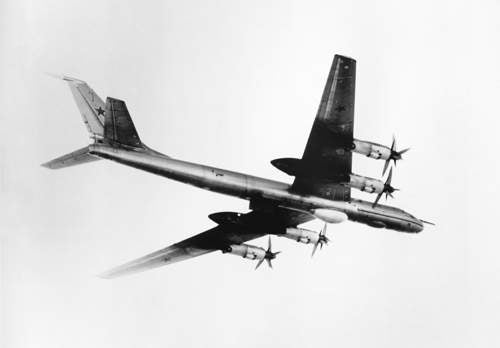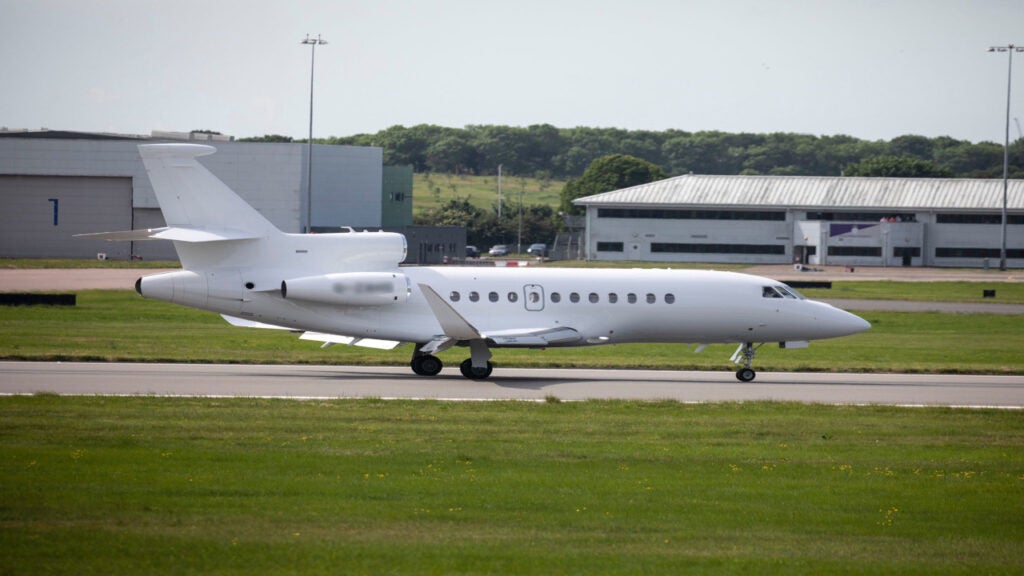
The Tupolev Tu-95 has been built in many Tu-95 and Tu-142 variants, but was originally constructed as a strategic, intercontinental heavy-payload bomber aircraft.
The aircraft is in service in the Russian Air Force Naval Aviation and Russian Air Force Air Army units, as well as with the Indian Air Force.
Tu-95 Bear intercontinental bomber development
The Tu-95s were designed and built at the Tupolev Joint Stock Company aviation plant in Moscow. First flight of the Tu-95 was in 1954 and it entered service in 1956.
The Tu-95 has a maximum level speed of 650km per hour and an unrefuelled combat radius of 6,400km. With one in-flight refuelling, the aircraft has a combat radius of 8,200km.
The Tupolev aircraft regularly made long-range patrols near Nato and US airspace until the end of the Cold War. In August 2007, President Putin announced that the Russian Air Force would resume long-range patrols by Tu-95 and Tu-160 strategic bombers after a gap of 15 years.
In July 2007, two Tupolev Tu-95 aircraft headed towards Scotland and were met by UK RAF Tornado aircraft. In August 2007, two Tupolev Tu-95 aircraft flew towards a US air and naval exercise near the US military base at Guam. That same month, two UK RAF Typhoon aircraft were scrambled to intercept a Russian Air Force Tu-95 over the North Atlantic.
Tu95MS Russian Air Force Air Army variant
The Russian Air Force 37th Air Army operates the Tu-95MS (Tu-95M 55 Bear H) in four units, the 49th ITAP unit based at Ryazan, the 79th TBAP unit based in Ukrainka Air Base in Svobodny, the 182th TBAP unit based in Zavitinsk and 6213 BKHUAT based at Engels Air Base in the Moscow region.
In January 2010, two Russian Tu-95MS Bear strategic bombers executed a routine patrol over the Arctic Ocean from the Engels Airbase. The aircraft spent around 14 hours in air. This was followed by patrolling by four F-16 Falcon fighters (took off from Norwegian Air Force) and two B-45 Tornado strategic bombers (took off from the UK Air Force).
Another routine patrol flight was carried out by two Russian Tu-95MS Bear strategic bombers in April 2010. The patrolling took place over the Pacific Ocean after taking off from the Ukrainka Airbase. The Tu-95MS Bear bomber remained in air for about 15 hours by using instrumental guidance flights and in-flight refueling.
In July 2010, two Tu-95MS Bear-H strategic bomber aircraft created a new flight duration record of 40 hours by patrolling over three oceans.
Tu-142 Russian Air Force naval aviation variant
The Russian Navy has 32 Tupolev Tu-142 Bear naval aviation aircraft in service.
There are an estimated 20 Tu-142M (Bear F mod 2) anti-submarine warfare aircraft and 12 Tu-142MR (Bear J) submarine radio relay aircraft in service with the 240th GvUAP naval air base at Ostrov and with the 310th OPLAP naval air base at Mongokhto.
The Bear J radio relay aircraft are equipped with VLF communications sets with a VLF ventral antenna pod under the centre fuselage. The satellite communications radome is installed just to the aft of the flight deck canopy. The aircraft maintain communications between the submarines of the Northern and Pacific fleets and the Russian command stations.
Tu-142MK-E export variant of the Indian Air Force
The Indian Air Force 312 Squadron based at Arkonam operates eight Tu-142MK-E Aircraft (Bear F mod 3 export variant).
The aircraft entered service in the Indian Air Force in 1986 and is equipped for maritime patrol and anti-surface warfare, reconnaissance and search and rescue.
The mod 3 E-variant aircraft is a downgraded variant of the fully capable Tu-142MK mod 3. The Tu-142MK-E can be armed with the Sea Eagle ASM air-to-surface missile supplied by MBDA.
Cockpit
The cockpit accommodates a pilot and co-pilot. The forward compartment immediately behind the flight deck accommodates four or five crew members.
The communications operator and a navigator and defence systems operator are seated facing rearward on the port side.
The flight engineer’s station and a spare seat for an observer or training crew member face rearward on the starboard side. The bombardier / navigator officer’s station is in the centre of the cabin. The crew entry hatch is installed above the nose wheel bay.
The aircraft is equipped with a Radiotechniczny System Bliskiej Nawigacji (RSBN) Soviet-designed navigational aid.
The RSBN antenna is installed under the box tail radar radome near the base of the rudder, for example, at the base of the hinged section at the rear of the vertical stabiliser.
TU-95 Bear weapons and payloads
The TU-95 houses a large bomb bay at the centre of gravity of the aircraft, which is immediately aft of the wing central torsion box. The Tu-95MS Bear H is capable of carrying six KH-55 Granat (Nato designation AS-15 Kent) nuclear-armed long-range cruise missiles with a range of 3,000km. The missiles are mounted on a catapult launch drum in the bomb bay.
Alternatively, the aircraft can carry 14 Kh-SD anti-ship missiles with a range of 600km or eight conventionally armed Kh-101 air launch cruise missiles, which have a range of up to 3,000km.
The rear gun compartment is fitted with a twin barrelled GSh-23L cannon. The entry to the rear turret is separate from the main crew entry and is via a ventral hatch.
Sensors
The aircraft is equipped with a weather radar, a navigation and bombing radar and a gun fire control radar. The low probability of intercept Obzor navigation and bombing radar, Nato designation clam pipe, is installed under the nose section. The clam pipe radar has synthetic aperture radar mapping capability. The PRS-4 box tail warning and gun fire control radar is installed at the base of the rudder.
Infrared sensors of the Mak-UT IR sensor missile approach warning system are installed under the nose sections and on the top surface of the fuselage above the wings.
Electronic warfare
Electronic countermeasures pods are pylon mounted on the port and starboard side of the tail gunner’s station and fairings are visible on each side of the weather radar on the nose section.
The antennae of the terrain bounce jammer, which attracts approaching radar-guided missiles down towards the ground reflected signal and away from the aircraft, are installed on the underside of the nose and under the rear section of the fuselage.
Radar warning receiver antennae are installed on the fin and on both sides of the front fuselage.
The APP-50 chaff and flare decoy dispensers are installed in the main landing gear doors.
Tupolev TU-95 construction
The aircraft is an all metal construction, large high-performance aircraft with a distinctive high aspect ratio all swept wing, swept at 30°.
The fuselage is of circular cross section, fuselage diameter 2.9m, and of semi-monocoque design. The fuselage houses three pressurised compartments.
The wings and tailplane leading edges are fitted with anti-icing heating. The aircraft carries three life rafts.
Turboprop engines
The aircraft is powered by four Samara Kuznetsov NK-12MP turboprop engines each rated at 11,033kW. The engines are fitted with eight bladed (two sets of four) contra-rotating propellers type AV-60N, of diameter 5.6m.
The aircraft has four wing tanks and three tanks in the fuselage, two in the centre and one in the rear section. The total fuel capacity is 95,000l. The aircraft has in-flight hose-and-drogue refuelling capability. The refuelling probe is above the nose and is fitted with flush lighting for night time operation. The information friend or foe antenna is installed above the refuelling probe.
The engines drive eight GSR-18000M generators for Type 12 SAM-55 accumulator batteries which provide DC power. AC power is provided by converters and four engine-driven AC generators. A gas turbine auxiliary power unit is installed in the dorsal fin.
Landing gear
The aircraft is fitted with tricycle-type hydraulically retractable landing gear. The four-wheel main units and the steerable twin-wheel nose units retract rearwards.
The main landing gear nacelles are installed on the wing trailing edge. The units are fitted with hydraulically operated internal expanding-type brakes.
Performance of the TU-95 Bear
The Tu-95 Bear can climb at the rate of 10m per second. The maximum and cruise speeds of the aircraft are 920km per hour and 710km per hour, respectively.
Its range is 15,000km. The combat radius and service ceiling of the aircraft are 6,400km and 12,000m respectively. The aircraft weighs around 94,400kg and its maximum take-off weight is 188,000kg.




